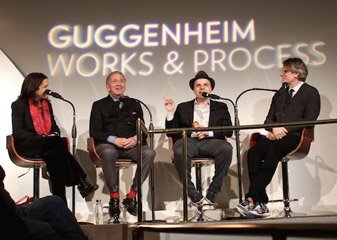In the Israeli-Palestinian talks at the heart of Oslo, the displacement of people is a negotiating point. One evening this week, it was the play’s cast who changed places. They moved from their LCT rehearsal room on the Upper West Side to the Guggenheim Museum on the Upper East Side, to take part in a Works & Process event. In this series, writers, actors, and directors share thoughts about how a piece comes together, interspersed with performance excerpts.
The evening began with journalist Elizabeth Rubin interviewing the production’s author, J.T. Rogers, and director, Bartlett Sher, as well as the story’s real-life inspiration, diplomat Terje Rod-Larsen, about the project’s beginnings. Referring to Blood and Gifts, a previous Rogers/Sher collaboration at LCT, Rogers said, “Bart set up Terje and me to have drinks after a performance. So the seed for Oslo was planted over martinis that night at P.J. Clarke’s” – a watering hole across the street from Lincoln Center.
After the cast performed the first of the play’s 64 scenes, Larsen was asked how faithful the drama was to what happened. He replied that the opening was very close to what had occurred at the beginning of the peace process, in January 1993, and that Rogers had dramatized the entire negotiation very well, but that the play “is not a documentary. What it does so masterfully is to capture the spirit of the Oslo accords.”
Asked about his collaborative process with Rogers, Sher said: “When I get a script from him -- with anyone -- I don’t try to fix it. I try to explore it.” Rogers elaborated: “Bart and I have different roles to play in the process, but we tend to view the drama of an event the same way. That makes for a shorthand.”
After the cast performed a scene from Act 2, in which primary negotiators Uri Savir and Ahmed Qurie summarized some of the stark actions committed by the Israelis and Palestinians, Rubin asked Larsen if in the negotiation he was pro-Palestinian or pro-Israeli. “I’m pro-both,” he replied. As the process was in formation, he realized that “the talks had to be secret” and that “we had to get Arafat” – the chairman of the PLO, Yasser Arafat – “involved.”
Larsen said that “I am funny in the play but maybe not so funny really,” an assessment that was frequently belied by a humor as dry as the martinis he and Rogers shared the night of their meeting. For example, of his quite bibulous encounters with Fathi Arafat, the physician brother of Yasser Arafat, Larsen said, “He liked a drop of Scotch.”
Just before the actors performed a scene from Act 3, in which final negotiating points are being hammered out, Rogers briefly discussed the difference between last summer, when the play premiered at LCT’s Mitzi E. Newhouse space, and now, as it readies a move into the larger Vivian Beaumont Theater. “What felt historical yet urgent – getting the Israelis and Palestinians into a room together – now feels even more pressing in light of current politics: how do you get implacable enemies to talk to each other?”
I plan to address some of the more concrete differences between Oslo in the Newhouse and Oslo in the Beaumont in my next blog entry.
Brendan Lemon is the editor of lemonwade.com
